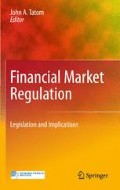Abstract
As recovery from the present economic crisis begins, policymakers must address what reforms will be made in the financial system in order to prevent the reoccurrence of a similar crisis in the future. In formulating these reforms, policymakers will also have to address the heightened moral hazard and broadened too big to fail doctrine associated with the bailouts of financial firms. These policies to deal with the impact of the crisis have resulted in large federal government deficits, a monetary base expansion with the potential for future inflation, and the depletion of the Federal Deposit Insurance Corporation’s (FDIC) Deposit Insurance Fund (DIF). What will Congress do in response? In terms of long-term financial reform, what is to be expected from Congress is passage of legislation that increases oversight and regulation by the federal financial regulatory agencies. Will the Federal Reserve System (Fed), or some other new or existing federal agency, be given additional regulatory and supervisory power to manage system risk? Will these reforms invite regulatory avoidance behavior by financial institutions or will financial innovation be stifled? These are the important questions that must be answered by any proposal to reform our financial system.
This chapter also appeared as Networks Financial Institute Policy Brief 2009-PB-05.
Access this chapter
Tax calculation will be finalised at checkout
Purchases are for personal use only
References
Bossone B (2001) Should banks be narrowed? IMF Working Paper 01/159. http://www.imf.org/external/pubs/ft/wp/2001/wp01159.pdf
Bryan L (1991) Core banking. McKinsey Q 1:61–74
Buiter W (2007) Would narrow banking prevent another Northern Rock? FT.com 22 Sept
Burnham JB (1991) Deposit insurance: the case for the narrow bank, in regulation. Cato Rev Bus Gov 14(2):Spring
Cao J, Illing G (April 2009) Endogenous systemic liquidity risk. CESifo Working Paper Series No. 2627. http://ssrn.com/abstract=1393186
Economist Staff (2008) Confessions of a risk manager. The Economist, 7 Aug
Ely B (1991) The narrow bank: a flawed response to the failings of the federal deposit insurance, regulation. Cato Rev Bus Gov 14(2):Spring
Fisher I (1935) 100% money. Adelphi Company, New York, NY
Friedland J (1994) The law and structure of the international financial system: regulation in the United States, EEC, and Japan. Quorum Books, Westport, CT
Friedman M (1965) A program for monetary stability. In: Kendall LT, Ketchum MD (eds) Readings in financial institutions. Houghton Mifflin, Boston, MA, pp 189–209
Gola C, Roselli A (2009) The UK banking system and its regulatory and supervisory framework. Palgrave Macmillan, Houndsmill, UK
Harrod RF (1969) Money. Macmillan, London
Herring RJ, Litan RE (1995) Financial regulation in the global economy. The Brookings Institution, Washington, DC
Hetzel RL (1985) The rules versus discretion debate over monetary policy in the 1920s. Federal Reserve Bank of Richmond. Econ Rev 71(Nov/Dec):5–9
House of Commons Treasury Committee (2008) The run on the rock. Fifth Report of Session 2007–2008. I(Jan):13–14
James KR (2007) The case for narrow banking. Central Bank of Brazil, 2nd Annual Seminar on Banking, Financial Stability and Risk, Sao Paulo, 7 May. http://www.bcb.gov.br/Pec/seminarios/SemMetInf2007/Port/KevinJames.pdf
Jessup P, Bochnak M (1992) A case for a U.S. postal savings system. Challenge 25(Nov/Dec): 5–60
Kobayakawa S, Nakamura H (2000) A theoretical analysis of narrow banking proposals. Monet Econ Stud 18(1):May. http://www.imes.boj.or.jp/english/publication/mes/fmes00.html
Lawson N (2009) Capitalism needs a revived Glass-Steagall. Financial Times, March 16
Litan RE (1987) What should banks do? The Brookings Institution, Washington, DC
Miles W (2001) Can narrow banking provide a substitute for depository intermediaries? Federal Reserve Bank of St Louis, First Annual Missouri Economics Conference, 4–5 May. http://research.stlouisfed.org/conferences/moconf/papers/miles.pdf
Mishkin F (1999) Financial consolidation: dangers and opportunities. J Bank Finance 23(2–4): 675–691, Feb
Padoa-Schioppa T (2004) Regulating finance: balancing freedom and risk. Oxford University Press, Oxford, UK
Phillips RJ (1995a) The Chicago plan & new deal banking reform. M.E. Sharpe, Armonk, NY
Phillips RJ (1995b) Narrow banking reconsidered: the functional approach to financial reform. Levy Institute Public Policy Brief, no. 18/1995. http://www.levy.org/pubs/ppb17.pdf
Pierce JL, Leone RC (1993) The future of banking. Yale University Press, New Haven, CT
Pollock AJ (1992) Collateralized money: an idea whose time has come again. Challenge 35(Sept/Oct):62–64
Shy O, Stenbacka RA (June 2000) Bundling argument for narrow banking. http://ozshy.50webs.com/narrow26.pdf
Simons HC (1948) Economic policy for a free society. University of Chicago Press, Chicago, IL
Spong K (1996) Narrow banks: an alternative approach to banking reform. In: Papadimtriou DB (ed) Stability in the financial system. St. Martin’s Press, New York, NY, pp 360–384
Tobin J (1987) The case for preserving regulatory distinctions. In: Restructuring the financial system: a symposium sponsored by the federal reserve bank of Kansas City, 20–22 August:167–183. https://http://www.kansascityfed.org/publicat/sympos/1987/S87TOBIN.PDF
Wallace N (1996) Narrow banking meets the diamond-Dybvig model. Federal Reserve Bank Minneapolis Q Rev (Winter) 20(1):3–13. http://www.minneapolisfed.org/research/QR/QR2011.pdf
Wilmoth AE (2002) Restructuring the American safety net after Gram-Leach-Bliley. In: Gup BE (ed) The future of banking. Quorum Books, Westport, CT, pp 101–130
Author information
Authors and Affiliations
Corresponding author
Editor information
Editors and Affiliations
Rights and permissions
Copyright information
© 2011 Networks Financial Institute
About this chapter
Cite this chapter
Phillips, R.J., Roselli, A. (2011). How to Avoid the Next Taxpayer Bailout of the Financial System: The Narrow Banking Proposal. In: Tatom, J. (eds) Financial Market Regulation. Springer, New York, NY. https://doi.org/10.1007/978-1-4419-6637-7_10
Download citation
DOI: https://doi.org/10.1007/978-1-4419-6637-7_10
Published:
Publisher Name: Springer, New York, NY
Print ISBN: 978-1-4419-6636-0
Online ISBN: 978-1-4419-6637-7
eBook Packages: Business and EconomicsEconomics and Finance (R0)

